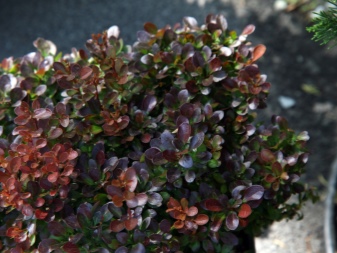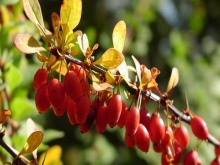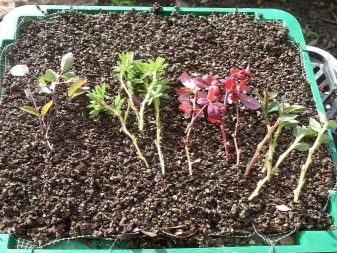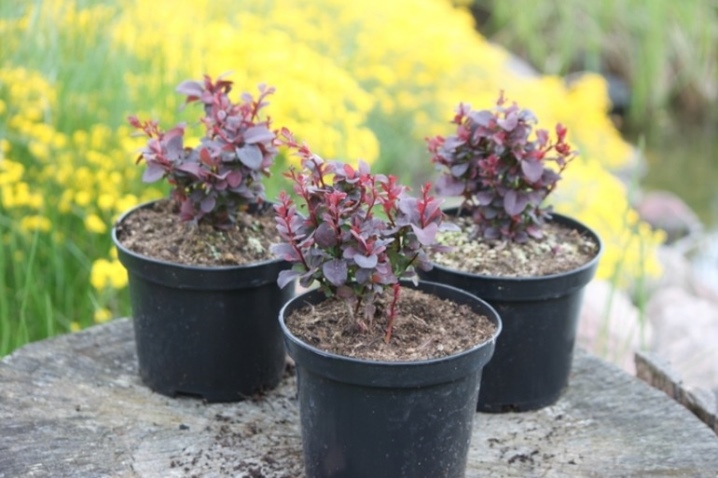Barberry Thunberg "Bagatelle": description, planting and care

Barberries are shrubs of expressive beauty. They can be used not only for decorative purposes, but also in treatment with traditional medicine methods. You just need to know the features and nuances of each variety in order to exclude all kinds of mistakes.


Peculiarities
Description of the barberry Thunberg "Bagatel" can begin with the fact that it is one of the most popular varieties. The plant is relatively compact. The width and height of the bushes does not exceed 0.4 m. The haircut allows you to create a ball shape that is great for barberries. Young shoots are colored red and brown, but with the onset of autumn they acquire a rich brown tint.


Foliage at Bagatelle in bright sunlight has a bright purple color. The width of the leaf is approximately 0.01 m. The leaves themselves have an ovoid configuration. In shaded areas, there is a red-green color of foliage. But with the onset of autumn, it changes again to a bright red color; with the approach of cold weather, the foliage falls off.
The annual growth of branches is approximately equal to 0.02 m. The flowering of the Bagatelle barberry is accompanied by the appearance of medium-sized yellowish flowers. You can see them in May and June. Ripening of barberry berries occurs in the second half of September. These fruits are elongated, shiny in bright light and completely edible.



Use in landscape design
Barberry Thunberg is very widely used in the design of gardens, vegetable gardens and home space. This plant is suitable for the formation of trimmed hedges and other fences. But you can also use such a culture in group plantings along with other varieties of barberries. This does not mean, of course, that it cannot be used as a tapeworm. True, the best conditions for such an application are created in sunny places.


There are quite a few types of group plantings of barberry. Each of these species is outwardly attractive. If you work hard and think over the concept, you can design a very beautiful site. A monochrome landscape, decorated with one sort of Bagatelle, also looks good. The use of a plant in landscape design is also within the power of even non-professional decorators.


How to plant?
Barberry Thunberg is relatively unpretentious, but there are a number of subtleties and nuances, ignoring which turns into sad results. The culture is in dire need of abundant illumination. Only in open sunny areas can you achieve a dense purple foliage color. But we must also remember about groundwater. "Bagatel" does not develop well on wetlands.

If it takes root there, then high humidity will provoke diseases of the root system. Acidity is not so critical for this plant. However, it is best to target a neutral ground.
Thunberg barberries can survive quite severe droughts and gusts of wind. Frosts are not particularly scary for them either. Therefore, in the simplest case, you can limit yourself to draining highly moistened soil.


It is worth digging holes for seedlings in advance. This is done about 12-14 days before the expected disembarkation. The gaps between the plants are selected according to the garden design scheme:
- in solitaire mode - from 1.5 to 2 m;
- in dense hedges - 4 bushes per 1 running meter;
- in free hedge mode - 2 bushes per 1 running meter.


A small layer of coarse sand is laid down into the hole. When the soil is very damp and the groundwater is close to the surface, the sand should be preceded by pebble drainage. The width of the recess should be such that the root system can fit with a margin. It is advisable to lime acidic soil. You can neutralize an undesirable reaction by using 0.3 kg of slaked lime per 1 sq. m.
It is necessary to plant the bagatelle barberry with the help of a nutrient mixture. In its manufacture, the same volume is used:
- sand;
- humus;
- garden soil.
The nutrient composition is poured in the form of a slide above the drainage layer. When deepening the seedling, the root system should be straightened with great care. Immediately after this, pour out the rest of the nutrient mixture. Stop backfilling as soon as the root collar is at the soil level. The soil is compacted, thoroughly shed and mulched with peat.


How to care?
Barberry "Bagatel" reacts extremely negatively to excessive moisture. The best irrigation option is drip irrigation. If you cannot organize it, you need to look carefully so that the root system does not sour. In the rainy season, watering is completely excluded - the plant will have enough natural precipitation. It is not necessary to somehow feed barberries in the first 2 years of development.
After 2 years, the time comes to use nitrogen fertilizers. 0.03 kg of urea is diluted per 10 liters of water. This feeding is enough for the next 3 years. Additionally, just before flowering, it is worth using fertilizers in granules. Sometimes in the fall of the second year potash mixtures are added.


Weeding barberries is not done according to the schedule, but as needed. The situation is exactly the same with loosening the earth. Attention: it is imperative to loosen the soil before feeding. Ignoring weeds leads to the spread of diseases and pests. Even if the plants do not die, they will lose their characteristic attractive appearance.

You can trim the Bagatelle barberry almost without hesitation. But the lack of pruning will adversely affect its appearance and slow down development. Sanitary pruning of a crop is carried out in the spring, accompanied by the removal of frozen branches and branches affected by diseases or pests. Important: having found a dead branch during the growing season, you do not need to wait for the next spring. It is quite possible (and necessary!) To take the secateurs immediately.
When planning to create a hedge, forming pruning is carried out in the second year of development. This procedure is repeated in the first ten days of June and during August of each subsequent year. In this case, it is necessary to cut from 1/3 to 2/3 of the total length.
For your information: some types of hedges are formed without special pruning, you can only do with a hygienic haircut. The barberry planted in the form of a tapeworm can be decorated in an almost arbitrary way, but most often they are guided by the traditional shape of the ball.


Both sanitary and shaping trimming "Bagatelle" imply the use of only sturdy, thoroughly sharpened tools... If the onset of a snowless or little-snow winter is likely, a shelter made of peat, spruce paws or straw is used. In the first 2 years, shelter is mandatory regardless of the winter climate. In adult specimens, they are limited to the protection of the root area. If a particularly harsh winter is ahead, or it is quite likely in the local climate, the side branches must be bent to the ground; they are insulated only with spruce branches.

Reproduction methods
All gardeners can choose the option that suits their taste best. Sometimes they even resort to using cuttings and root shoots. Despite the moderate labor intensity and good prospects for plant development, this approach often threatens to lose the original varietal traits. The use of seeds is very difficult, in addition, 60% of them will not germinate even under ideal conditions. And in addition, it is possible to expect the appearance of seedlings suitable for transplanting into open ground only after 2 years.

The vast majority of people choose to propagate bushes by cuttings. For this purpose, planting material is harvested both in summer and autumn. But with summer cuttings, the chances of success will be higher. You can try and share the bush. Seedlings require the most careful care in the first year of development, otherwise they will not take root and will not bloom.


Bagatel container seedlings are planted in spring, summer and autumn. Usually the transshipment method is used. If the root is bare, transplantation is possible only in early spring, when the earth is ready to receive the plant, and the buds have not yet activated. When working with both seedlings and adult plants, one must remember that the barberry has thorns, even if there are few of them. We'll have to wear strong gloves.

Review of the barberry Thunberg "Bagatel" in the video.



































































The comment was sent successfully.